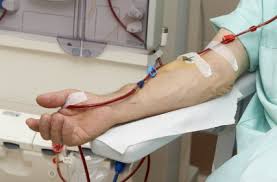Numbing Dialysis Needle Sites
Dialysis needle insertion can cause pain and anxiety – numbing dialysis needle sites can reduce the associated pain
Many Chronic Kidney Disease patients who undergo or conduct hemodialysis treatments often are fearful and/or distressed about having to get stuck with large needles at the beginning of every dialysis treatment – which can be very painful. This is a serious issue which causes some patients to become anxious before and during treatments, depressed, and even contemplate the idea of stopping dialysis altogether.
How do people deal with the anxiety and pain associated with needle sticks? Many patients and their clinicians use topical anesthetics for numbing dialysis needle sites as one common approach. Numbing agents include: lidocaine, lidocaine/prilocaine and tetracaine (amethocaine) creams and cold sprays.
Pain and anxiety associated with dialysis needles is a very important issue and should not be taken lightly. The pain from hemodialys cannulation is well-known among both patients and healthcare workers who treat them. The mere anticipation of the insertion of the large gauge needle can cause a high degree of anxiety in addition to the pain itself. Increasingly more common, is the growing use of therapies used to mitigate some of the pain associated with this procedure.
Numbing Dialysis Needles Sites
Numbing dialysis needle sites using topical anesthetics can often safely and effectively decrease the associated pain. Some topical anesthetics are more effective than others. There are a variety of formulations currently on the market that address numbing dialysis needle sites. Some of the commonly used topical anesthetics have an onset of action that can take up to 60 minutes or more before they begin to exert their full effect. There are others that include ingredients added to improve the permeability of the skin allowing the active ingredients, lidocaine for example, to be delivered more rapidly into the skin, thereby exerting their effect more rapidly.
Topical anesthetics used for numbing dialysis needle sites that require a longer set up time can be applied by the patient at home prior to in-clinic treatment visits. While those that have a more rapid onset can be applied onsite at the treatment site. After application, the patient should cover the access with saran wrap to protect clothing and ensure that the medication is not wiped off prematurely. NEPHROLOGY NURSING JOURNAL ■November-December 2005 ■Vol. 32, No. 6
As awareness and empathy toward patient comfort and anxiety continues to improve, management methods and growing widespread use increases to support positive outcomes and patient satisfaction. In nursing, one of the primary expectations of clinician care is to provide comfort, especially in regard to hemodialysis treatment. Patients and their families believe that the patient’s comfort is an important factor in patient compliance. Iran Red Crescent Med J. 2014 Jul; 16(7): e19055. Published online 2014 Jul 5
Healthcare workers working together while sharing the common goal of improving patient comfort, compliance, experience and satisfaction, should consider continually employing methods to support reducing pain and pain associated anxiety as a means to improving positive patient outcomes.


